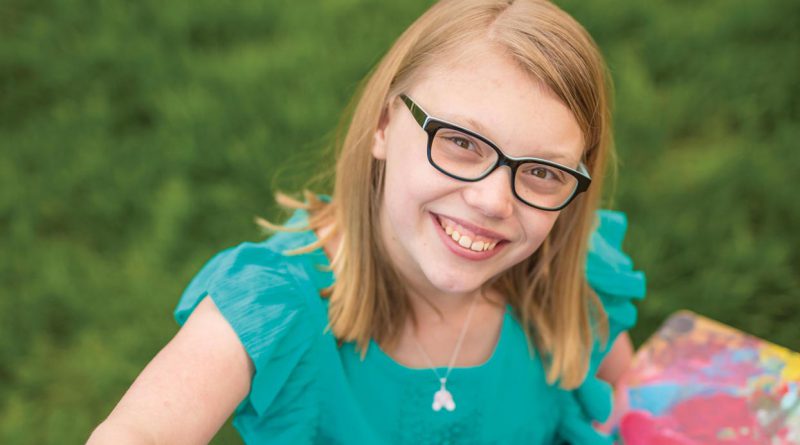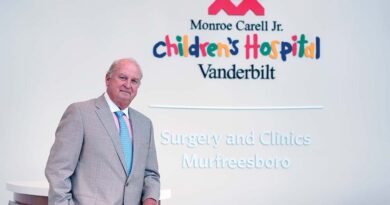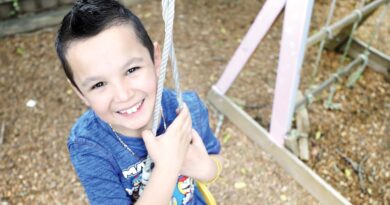The Art of Caring
Published on June 13th, 2018 by Christina Echegaray.
Seven-year-old Sarah Pryor couldn’t walk up a flight of stairs in December 2012 without gasping for air. Her father, Ben, had to carry her upstairs to bed where she slept propped up against her mother, Jody. If she lay down, she couldn’t breathe.
Her heart was failing, but more than two years of doctors’ visits at two children’s hospitals in Missouri — pediatricians, neurologists, cardiologists and pulmonologists — hadn’t answered the one question Jody and Ben needed answered: what was wrong with their daughter?
After a series of frustrating misdiagnoses, a move to Middle Tennessee and the good fortune of ending up with the pediatric pulmonary hypertension team at Monroe Carell Jr. Children’s Hospital at Vanderbilt provided the Pryor family with a diagnosis — Sarah, now 13, had pulmonary arterial hypertension (PAH), a subtype of pulmonary hypertension (PH). It’s a chronic and life-threatening disease that can lead to right heart failure if untreated.
PH is a condition of high blood pressure in the blood vessel system that delivers de-oxygenated blood from the right side of the heart to the lungs, and returns oxygenated-rich blood back to the left side of the heart for subsequent delivery to the body. The elevated blood pressure strains the right ventricle of the heart over time. This can cause heart failure, which is the most common cause of death in people who have PH.
After the diagnosis, Jody said, “I realized how horrible it was.”
Most children with PAH progressively worsen over time. There is no cure, although many children respond to treatment that can lessen symptoms and improve their quality of life. Median survival for children with PH is seven years after diagnosis. Before current medications were available, it was two to three years.
The symptoms of pulmonary hypertension in its early stages might not be noticeable for months or even years. They include shortness of breath during normal activities, fatigue, dizziness, fainting spells, chest pain and a racing heartbeat. At its worst, the condition may limit all physical activity.
About 200 children with PH are currently treated by the pediatric pulmonary hypertension team at Children’s Hospital, a component of pediatric pulmonary medicine which is ranked 13th in the nation by U.S. News and World Report. Children treated in the pulmonary medicine program have access to nationally recognized experts in common and complex breathing problems including PH, primary ciliary dyskinesia (PCD), cystic fibrosis, bronchopulmonary dysplasia, asthma and other conditions.
Children’s Hospital is one of eight accredited pediatric comprehensive care centers in the country caring for children with PH and the only accredited program in the Southeast, said Sarah’s physician, Eric Austin, MD, MSCI, associate professor of Pediatrics.
“We offer a comprehensive, multidisciplinary approach for children with PH with a physician and nurse practitioner, along with dietary, palliative care and pharmacy support,” Austin said. “Our pulmonary hypertension care is centered around a collaborative network of physician/scientists.”
PH, which is caused by a gene mutation in about 20 percent of the cases, can be idiopathic, with no known cause. Other conditions can also result in PH, including congenital heart disease, chronic lung disorders, blood clots in the lungs, etc. Sarah’s form of PH is idiopathic.
Improving screening and treatments for cystic fibrosis
In 2015, for the first time, adults with cystic fibrosis (CF) outnumbered children with the disease. Read more »
Sarah’s one and one-half year “crazy journey” to diagnosis was harrowing for Sarah, Jody and Ben. In perfect health until age 6, at the end of her kindergarten year in Missouri, Sarah fainted in the hallway at school. A witness saw her grab her chest and fall face first to the ground. Her parents took her to two children’s hospitals in Missouri, where they were told her episode had been a seizure.
Episodes of fainting, shortness of breath and what were believed to be seizures persisted. At first, the episodes occurred when she was doing some sort of basic physical activity, like climbing stairs, and later, when she was at rest. She saw neurologists, cardiologists and pulmonologists. The physicians didn’t think the seizures and shortness of breath were related. Her parents insisted they were.
When the family moved to Franklin, Tennessee, in 2012, Sarah’s condition, still undiagnosed, was progressing rapidly. Their pediatrician sent them to a Nashville cardiologist who was concerned about a possible rhythm problem with her heart. He referred them to Vanderbilt pediatric cardiologist Frank Fish, MD, who recognized the possibility of PH. Fish referred her for further testing by Dana Janssen, MD, an interventional cardiologist and member of the Pediatric PH Program, who performed a heart catheterization which formally diagnosed Sarah with PH.
She was then immediately referred to Austin and the pediatric PH team at Children’s, including Anna Brown, DNP, CPNP. “Dr. Austin and his team have been by our side ever since the day Sarah was officially diagnosed,” Jody said.
By the time most patients are referred, they’ve had symptoms for two or three years, Brown said. “PH is a challenging condition to diagnose early, because even if you have sustained high pressures for a while, you may not see signs or symptoms.”
Finding the right treatment
Current available therapies slow down the progression of the disease but won’t cure it. The therapies work in different ways to relax the pulmonary arteries to relieve stress on the right side of the heart. They include oral therapies to target different biologic pathways relevant to PH, inhaled versions of these medications, and continuously infused versions of these medications. For the continual infusions, children are connected to small pumps for delivery of the medication to the skin or blood vessel, similar to insulin pumps for diabetes. While only one therapy is approved for use in pediatric patients by the Food and Drug Administration, all the therapies are used by specialists in the pediatric PH field.
Sarah is currently on three oral medications and one-half liter of oxygen at night and her pressures have decreased, Jody said. She has a difficult time during cold and flu season and her parents have to be extra cautious to keep her away from anyone who is sick. Like other children, Sarah gets respiratory infections and other illnesses, although these may be harder for a PH patient to recover from.
Still, Sarah is one of the “rare of the rare,” Jody said. “PH is a rare disease and Sarah is even more rare because she responds so well to treatment. We are grateful that she is doing well, but we never forget her prognosis. We know that things could change at any time…I don’t know how long Sarah would have been with us if we hadn’t been referred to Vanderbilt.
“I know they care for Sarah deeply and want what is best for her. They encourage us and help us make tough decisions. I would travel across the country if we ever moved so Sarah could continue treatment with them.”
The quality of life for PH patients varies depending on the subtype, Austin said. “At the highest challenge of illness there’s a massive impact on quality of life. For example, several of our patients are able to get to and from their car and around their house, but get winded beyond that. Many can’t play outside for any length of time or participate in physical education. Our patients who have a continuous pump requirement can’t swim and they have to be careful not to dislodge their pump with typical daily activities. Children with PH have to think carefully about their activity and endurance; for example, for some children with a school on multiple levels, they need to wait on elevators all day long. So, many children with PH deal with a level of challenge and impact that’s quite burdensome.”
Brown said the only “cure” for PH is a lung transplant, “which in pediatrics is trading one set of problems for another, so we try to manage our patients with available therapies for as long as we can.” Average survival for pediatric lung transplant patients is five years. Many of Vanderbilt’s PH patients are referred for transplant evaluation and discussions early, but the transplant typically will not occur until the end of the disease, if at all.
“The quality of life post-transplant is often quite difficult and the timing of transplant is a multifactorial decision. In fact, not all children and families elect to pursue transplant. We aim to support our families with their decision-making regardless of their ultimate preferences,” she said.
Sarah’s parents have hopes for her future. Currently, she is homeschooled in Hendersonville, Tennessee. Her mom, Jody, wishes for Sarah to be able to attend high school, “so she can be a typical kid.” That will depend on her condition at the time. She loves arts and crafts, especially sewing, and enjoys acting and baking.
“We have hope for a cure in Sarah’s lifetime. Sarah is our comeback kid. She is tougher than she looks and is a fighter,” Jody said.
Delivering specialized care
Zion Horton, a kindergartener who lives in Lavergne, Tennessee, is another patient seen by the pediatric pulmonary team at Children’s Hospital. Zion, a bubbly, vibrant and active 5-year-old, has a “smile as big as her hair,” says her mom, Valency. “She lights up a room,” she adds.
Zion was diagnosed with primary ciliary dyskinesia (PCD) in her mother’s womb. PCD is an inherited rare disease that affects tiny, hair-like structures that line the airways, including nasal passages, sinuses, lungs, Eustachian tubes of the ear, the reproductive organs and ventricles of the brain.

Cilia move together in wave-like motions and carry mucus toward the mouth to be coughed or sneezed out of the body. The mucus contains inhaled dust, bacteria and other small particles. If the cilia don’t work well, bacteria stay in your airways and can cause breathing problems such as frequent cough and recurrent pneumonia. Cilia dysfunction can also lead to ear and sinus infections, along with hearing and speech development issues. In addition, about 75 percent of individuals with PCD have a history of breathing difficulty at birth. PCD can also cause fertility issues because sperm cells have structures that are like cilia and there can be faulty cilia in the fallopian tubes.
“PCD affects the lung’s ability to get rid of the normal things we breathe in every day and creates extra mucus in the lungs, putting these kids at risk for respiratory infections and pneumonia over and over again,” said Michael O’Connor, MD, assistant professor of Pediatrics.
PCD affects between one in 10,000 and 30,000 births, but most children born with PCD have a normal lifespan ahead of them. The Children’s Hospital pulmonary team follows about 50 children with PCD.
Ciliary activity is also responsible for organ placement in the developing embryo. A condition called Situs inversus totalis occurs in about 50 percent of all PCD patients, including Zion whose heart, stomach, liver and spleen are on the opposite side of the body from where they should be.
“While PCD is a rare disease, there is a significant need for increased awareness of the disease, both in the community and among health care providers,” said Lisa Young, MD, associate professor of Pediatrics, who co-directs the PCD Center with O’Connor. Vanderbilt’s is one of 40 centers accredited by the PCD Foundation throughout the United States and Canada.
“It can take a long time to get to this diagnosis. PCD is not just misdiagnosed. What’s more common is it’s missed altogether,” Young said.
Children’s Hospital is also one of a limited number of centers and one of only two centers in Tennessee that offers specialized nasal nitric oxide testing to diagnose PCD. It’s a simple test in which a tiny foam piece with suction (about the size of a miniature marshmallow) connected to an analyzer is inserted into your nose to measure the level of nitric oxide in the nasal cavity. People with PCD have very low levels of this gas in their sinus cavity. “It’s a very reliable test, and we are quickly learning how helpful this testing can be in making a diagnosis of PCD,” O’Connor said.
Long-running clinic helps premature babies with lung disease
Premature babies born with underdeveloped lungs often receive pressurized oxygen from machines to help them breathe. But sometimes the machines can damage the babies’ delicate airways and cause respiratory distress syndrome. Read more »
Valency, who said Zion has good and bad days, said that she tries to instill in her daughter that PCD is what she has, not who she is. “It doesn’t define her, but we’ve taught her to be her own advocate as well, to speak up for herself (if there are respiratory irritants around her). We don’t want PCD to hinder her in her day-to-day activities.”
But the family, which includes Zion’s 8-year-old sister, Nia, 21-year-old brother, Edward, and father, Emmanuel, does have to build in time each day for Zion’s airway clearance. Although it sounds simple, it’s crucial that she blow her nose thoroughly throughout the day — to help clear mucus. She wears a heavy airway clearance vest twice a day (before school and before dinner) and takes medication to keep her airway clear. Nia attends the same school and can check on Zion throughout the day.
Children with PCD are seen by a multidisciplinary team at Children’s Hospital, including pediatric otolaryngology and respiratory therapists. They are monitored closely for respiratory infections and treated aggressively with antibiotics if they develop one.
“We’re partnering with other centers around the country to implement new therapies to improve care for our patients,” Young said. “PCD has been a very lonely diagnosis and we’re working to change that by setting up accredited centers providing education to families and their providers about the diagnosis, and by conducting research to improve our understanding of PCD and develop new therapies.”
Zion has come a long way in understanding PCD, Valency said. “When she was around 3 or 4, she couldn’t understand why she was the way she was. She cried a lot because she didn’t understand. We did a lot of explaining and told her she was uniquely created and that God has a purpose for her.
“Now she’ll tell people ‘I have PCD. My heart is here (points to the right side of her chest) and yours is there (points to the left).’ We’ve also helped explain her condition at school so she doesn’t feel different. The pledge of allegiance seems like a minor thing to teach your child, but she came home and said ‘I’m supposed to put my hand over my heart. Is it OK to put it where my heart is, or where everybody else’s is,” Valency said. “We told her either side is just fine.”
– by Nancy Humphrey




